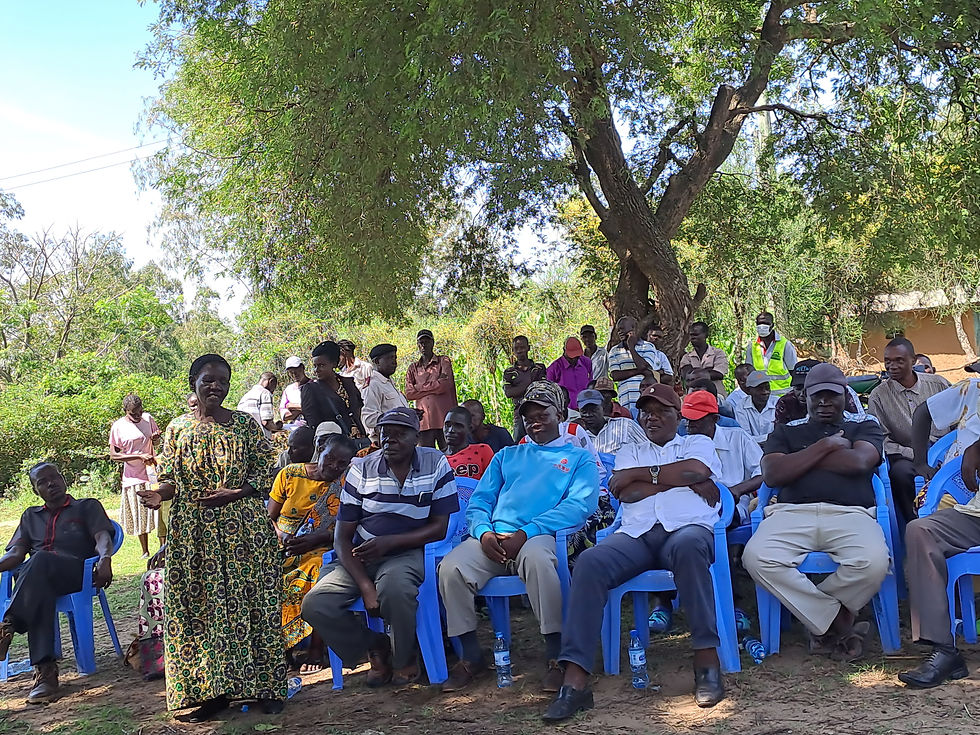
SAFEGUARDING
PROJECT AFFECTED
COMMUNITIES
PROJECT MEASURES TO PREVENT GBV/SEAH/VAC
The Lower Nzoia Project is committed to safeguarding the rights and wellbeing of communities affected by project activities. A comprehensive set of social and environmental protection measures has been put in place to ensure that development is inclusive, participatory, and sustainable.
The project has adopted a robust strategy to prevent Gender-Based Violence (GBV), Sexual Exploitation, Abuse and Harassment (SEAH), and Violence Against Children (VAC), with a strong focus on awareness, training, and safe reporting. This strategy is integrated across all project activities and has been incorporated into the Apex Irrigation Water Users Association (IWUA), with committee members selected to support prevention and response efforts at the community level.
Achievements:
-
Community Training & Codes of Conduct: All workers and community members engaged in the project receive training on GBV/SEAH/VAC prevention. Codes of Conduct have been signed to reinforce accountability and ethical behavior.
-
Awareness in Schools: Murals promoting safety and positive behavior have been painted in 36 schools within the project area, targeting both learners and the wider community.
-
Capacity Building: Teachers and Community Focal Point Persons (Champions) have been trained to identify, respond to, and report GBV/SEAH/VAC incidents, enhancing early intervention and support mechanisms.
-
Community Focal Point Persons (CFPPs): Trained CFPPs act as liaisons between the project and local communities. They support grievance management, awareness campaigns, and link survivors to local service providers.
-
Toll-Free Number: A dedicated toll-free number has been established and shared with CFPPs and community members to facilitate safe, confidential reporting and referrals.
-
Information Materials: Awareness is further supported through posters, murals, and community meetings that promote inclusion, rights, and safety across all levels.
This comprehensive approach ensures that safeguarding is embedded in project implementation, with clear channels for community support, response, and prevention.
LIVELIHOOD
RESTORATION ACTIVITIES
To restore and improve livelihoods, the project is implementing tailored Livelihood Restoration Programs (LRPs) for affected households. These include support in agriculture, small businesses, and vocational training, ensuring long-term economic resilience for the PAPs.

To restore and improve livelihoods, the project is implementing tailored Livelihood Restoration Programs (LRPs) for affected households. These include support in agriculture, small businesses, and vocational training, ensuring long-term economic resilience for the PAPs.
Strict adherence to EHS standards is maintained throughout the project to ensure the health and safety of workers and communities. This includes regular site inspections, compliance monitoring, and awareness sessions on environmental conservation and workplace safety.
A structured Grievance Redress Mechanism is in place to receive and resolve complaints from community members efficiently and fairly. Grievances can be submitted through various channels, including community focal persons and a toll-free line, ensuring accessibility for all.
Land acquisition for the project has been carried out transparently and in accordance with national laws and World Bank guidelines. Compensation has been provided to Project-Affected Persons (PAPs) to ensure they are not worse off due to displacement. Ongoing support is provided to resolve outstanding cases and safeguard vulnerable households. The Resettlement Action Plan (RAP) for the project outlines comprehensive monitoring indicators, including the number of PAPs compensated for land, structures, trees, and crops, as well as those supported through livelihood restoration programs.

ENVIRONMENTAL, HEALTH AND SAFETY
Strict adherence to EHS standards is maintained throughout the project to ensure the health and safety of workers and communities. This includes regular site inspections, compliance monitoring, and awareness sessions on environmental conservation and workplace safety.
GRIEVANCE REDRESS MECHANISM
A structured Grievance Redress Mechanism is in place to receive and resolve complaints from community members efficiently and fairly. Grievances can be submitted through various channels, including community focal persons and a toll-free line, ensuring accessibility for all.
.jpg)
LAND ACQUISITION
Land acquisition for the project has been carried out transparently and in accordance with national laws and World Bank guidelines. Compensation has been provided to Project-Affected Persons (PAPs) to ensure they are not worse off due to displacement. Ongoing support is provided to resolve outstanding cases and safeguard vulnerable households. The Resettlement Action Plan (RAP) for the project outlines comprehensive monitoring indicators, including the number of PAPs compensated for land, structures, trees, and crops, as well as those supported through livelihood restoration programs.
















